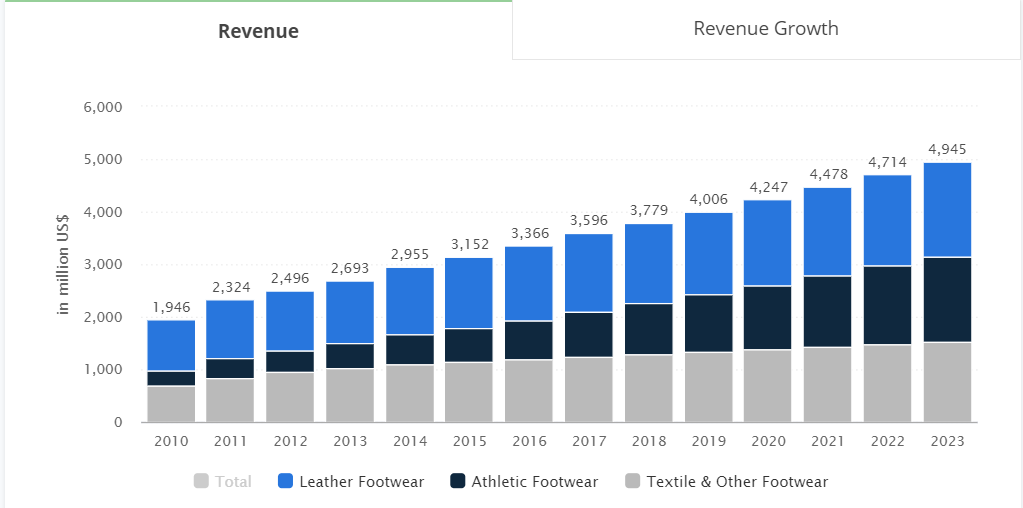Research and Development
Research and development are the first two steps critical to launching a new product or service. Research and development seek to pinpoint potential customers’ needs and preferences (Holweg & Helo, 2014). Possible contenders are also taken into consideration as the company endeavors to figure out what could be its competitive advantages. At this stage, drawing, processing, and analyzing reliable information as well as outlining core values and principles add value to the company’s processes. The latter ensures that the new business project is in line with the company’s vision and mission.
This may be the most important stage because if the company is to make mistakes at the beginning, it will be making decisions operating on a wrong premise. During the research and development stage, the company may decide to tap into a new market, namely, start selling athletic footwear in a country that it has no previous ties with. Graph 1 provides an example of Indonesia where the athletic footwear market revenue has been steadily growing for the last nine years.

Product and Service Process Design
The second stage entails designing a new product in alignment with the company’s findings during research and development. This function has the capacity to add value only if the company takes its time and pays attention to each of the steps essential for launching a new product. Between the blueprint and the end result, there are many other phases such as confirming, changing, testing, readjusting. Product and service process design can give the company a competitive advantage if the end product fits with the current trends and has characteristics that distinguish it from what contenders have to offer.
The most critical decision that the company’s managing board can make is whether to launch a new product officially or not. At that, managers can use accounting information such as product validation to guide the process. A product or a service is only validated if customers buy it during the pitching, or testing, phase. Otherwise, the prognosis for future sales may be far from optimistic.
Production
Where and how a product is manufactured can add to or subtract from the quality of a product. Nowadays, broad market tendencies lean toward outsourcing production abroad, especially to the developing countries. The end goal is usually to receive high-quality products at a lower price to make more profit. A piece of accounting information that may help a manager make a decision about whether the company should outsource or not is domestic vs. foreign manufacturing expenses. However, the situation may be more nuanced than that: using foreign workers’ labor is often seen as exploitation. Major clothes companies such as Zara and H&M are often reprimanded for this practice (Ndubisi & Nygaard, 2018). Thus, the Oregon company will have to weigh in both economic and social factors.
Marketing
Good marketing ensures that a new product or a service reaches its target audience. It also communicates the advantages of using the said product or a service and highlights the characteristics that distinguish it from its alternatives. This function within the value chain has the capacity of adding value by building a stronger presence, attracting more customers, and increasing profits. During this phase, the company’s managers need to decide what marketing channels they should use. Comprehensive statistics on the success of the previous marketing companies on TV, online, and using physical advertisement may guide their decision.
Distribution
Distribution may be one of the most challenging functions to harness. Logistics are an ever-evolving industry where major players are constantly introducing new ways of delivery. Moreover, more people than ever prefer online shopping, which has become another essential distribution channel. This function will add value by allowing customers to receive the desired products on time and enjoy the ease of making a purchase. It is important that the company’s managing board decides on the most appropriate distribution channel. For this, they might want to analyze information on online vs. physical store sales from previous years.
Customer Service
Ensuring that customer service is up to the company’s and market’s standards is essential to the viability of a product. This means training employees to be knowledgeable about a new product, diagnosing, and troubleshooting. Customer service is the final link in the supply chain and should be refined as needed. When adjusted correctly, this function may keep customers and add to customer lifetime value (Donovan, Franzel, Cunha, Gyau, & Mithöfer, 2015). At this point, one of the major decisions that a manager may need to make is whether to launch a customer loyalty program that would mean a comprehensive system of gifts and discounts. Theoretically, this is a viable initiative; however, there is a need for further research. A piece of accounting information that may help the company to settle on the best option is sales per customer over an extended period of time.
Questions
- How many shoes should the company produce annually to meet customers’ needs?
- How likely are customers to use the company’s services/ buy its products again?
- What is the company’s revenue compared to what its contenders are making?
- Does it make more economic sense to outsource manufacturing?
- What are the overall sales dynamics?
References
Donovan, J., Franzel, S., Cunha, M., Gyau, A., & Mithöfer, D. (2015). Guides for value chain development: A comparative review. Journal of Agribusiness in Developing and Emerging Economies, 5(1), 2-23.
Holweg, M., & Helo, P. (2014). Defining value chain architectures: Linking strategic value creation to operational supply chain design. International Journal of Production Economics, 147, 230-238.
Ndubisi, N. O., & Nygaard, A. (2018). The ethics of outsourcing: When companies fail at responsibility. Journal of Business Strategy, 39(5), 7-13.
Statista. (2019). Footwear. Indonesia. Web.